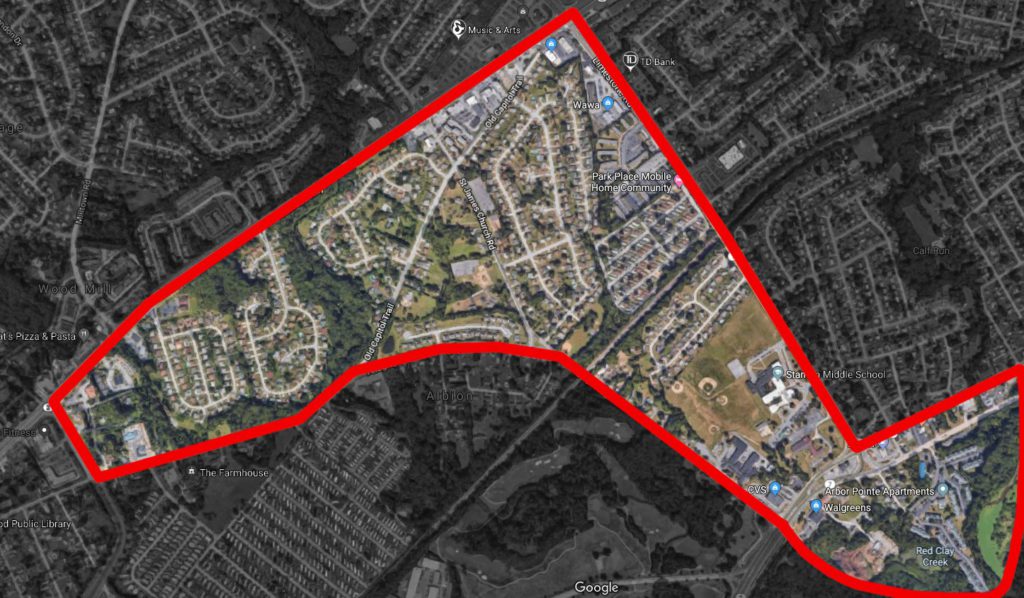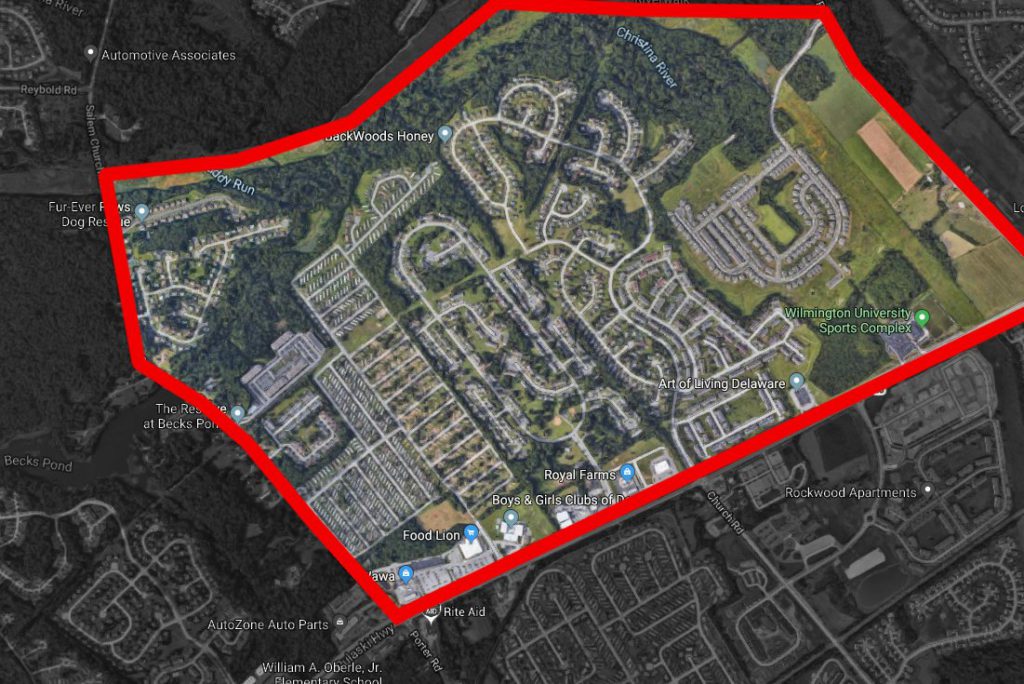America is a suburban nation, and not by accident.
Over the second half of the 1900s, a messy blend of government policies, economic changes, and old-fashioned racism transformed America into a suburban country. Today, just over half the country lives in a neighborhood they would describe as suburban. Dotted with white-picket fences, nuclear families, and single-family homes, these suburbs represent, for many, a new American Dream.
This change was especially large in Delaware. In 1920, half of the state’s residents lived in the city of Wilmington. Almost everyone else lived in rural areas across the rest of the state. One hundred years later, Wilmington is just seven percent of Delaware’s population, and rural areas make up less than twenty percent. Instead, the vast majority of Delawareans now live in the suburbs.
In Delaware, as with most places around the country, the suburbs are viewed as being mostly middle class and white. While this was never entirely true, it is a fair enough summary of what the suburbs have looked like for most of American history.
But over the last few decades, the suburbs have been changing. On top of being the largest source of overall population growth, they have also seen the largest increase in poverty. So much so, that about half of all poor people in the United States now live in the suburbs.
At first glance, the rise of suburban poverty may not seem like a big issue. It is still much lower than urban and rural poverty, and it hasn’t become systematic in the same way it has in these other areas. But it doesn’t take much for a trend to become an epidemic. If we do not address it soon, we run the risk of confronting an even worse version of institutional poverty: the kind that could mean disaster for a suburban state like Delaware.
By far, the best work on this subject is Confronting Suburban Poverty in America, written in 2014 by Elizabeth Kneebone and Alan Berube. It covers every part of suburban poverty: what it looks like, how it is growing, and its origins.
It is worth noting that the suburbs were never the cookie-cutter places they portrayed to be. While they were definitely richer and whiter than the cities, there were always low-income people and people of color that formed a small, but very real, minority in the suburbs. But in the last twenty years, these pockets of poverty began to multiply, developing into the systemic issue that we face today.
Some states have felt the impact more strongly than others. So far, Delaware has not been affected as much as states like Florida or Arizona. But, the warning signs are there, and we have to be ready for them. To understand what those warning signs are, we need to look back twenty years.
A HOUSE OF CARDS

The decade from 2000 to 2010 was possibly the worst for the average American since the Great Depression. While the Great Recession played a huge part in that, the collapse that it caused would not have been possible without the subtle rot that hollowed the economic system before 2008.
Despite national economic growth, the economy never realized the widespread prosperity that many had come to expect during the 1990s. Slow job growth and stagnant incomes prove that the economy never fully recovered from the stock market crash and short-lived recession in 2001. So while Washington was plowing forward with tax cuts and privatizing social security, the poverty rate began to rise. This increased precarity made many people prime targets for exploitation.
The most infamous form of exploitation during this time was the subprime mortgage boom. Banks targeted poor people, working-class people, and historically under-housed communities with predatory loans under the guise of increasing access to home-ownership. And these loans did not go to the cities and farms. Suburban residents made up 73 percent of all subprime mortgages.
Then in 2007, the grift came crumbling down. Once again, the victims were mostly the suburban poor. Follow the pattern of lending, 73 percent of foreclosures during that time were in suburban areas.
Meanwhile, as the subprime mortgage crisis turned into the Great Recession, the biggest job losses were among middle-income jobs. Then, during the recovery, the largest job gains were among low-income jobs. As a result, millions of Americans in the suburbs lost their primary asset and their solidly middle-class job simultaneously. Many ended up downgrading to a cheaper house or renting while working a job that paid less than what they had made before.
Of course, the recession did not impact every state equally. Initially, Delaware avoided the worst of the fallout. Unemployment peaked at 8.8%, and the foreclosure rate was well below the national average of 1.8%. However, as the months and years ticked by, Delaware didn’t bounce back in the same way other states did.
Before the recession, Delaware had a lower unemployment rate than most of the country: the 8th lowest in the nation. By 2014, it fell to the middle of the pack. And as foreclosures fell in the rest of the country, they increased in Delaware as the mortgage crisis continued to take its toll.
By 2016, Delaware topped the nation in foreclosures and has remained in the top three since then. In 2017, it was one of only two states in the country to have its poverty rate go up.
Delaware might not have experienced the immediate collapse of suburban wealth and housing like other states did, but the Great Recession made it clear that we are increasingly vulnerable.
THE NEW GREAT MIGRATION
While the mortgage crisis was making existing suburbans residents poorer, another set of trends began to push more and more poor people out of cities and into the suburbs.
One of the biggest drivers of migration to the suburbs was the lack of opportunity in cities. Urban renewal programs like HOPE VI allowed cities to demolish public housing towers and replace them with low-rise mixed-income communities. But these new communities frequently had fewer subsidized units or fewer units overall. The move forced predominately Black and Hispanic residents to find somewhere else to go. Many of these residents might have wanted to continue living in cities, but they had no choice but to leave.
As manufacturing and other industries left major US cities and vacancies increased, a new group of gentrifiers arrived, driving up housing prices as they moved in. The return of jobs allowed some people to stay. But for others, staying was not an option. Instead of moving into increasingly concentrated areas of urban poverty, many families opted to move out of the city entirely and find new homes in the suburbs.
Unfortunately, leaving the city did not prove to be the solution to poverty either. Poor families were generally only able to move into neighborhoods that were more low-income than average.
These same neighborhoods also attracted new immigrants trying to get a foothold in America. But for both foreign and domestic migrants alike, many of these suburban neighborhoods morphed into areas of concentrated poverty like the ones they had tried to escape.

In Delaware, this trend has yet to become widespread. But it is well underway in several areas. One example is the area west of Stanton, near the intersection of Kirkwood Highway and Limestone Road (pictured above). In 2000, this area had a poverty rate of 5.2% and a white population of 75.73%. Twenty years later, it has a poverty rate of almost 24.43%, with a population that is now 50.66% Hispanic.

It is a similar story in several neighborhoods near Route 40 (pictured above). In 2000, these areas had a poverty rate of only 8.56 percent and a relatively diverse population that was 53.89 percent white, 35.02 percent Black, and 6.59 percent Hispanic. Today, it has a poverty rate of 23.68 percent, and a population that is 28.53 percent white, 42 percent Black, and 26.04 percent Hispanic.
This is not to blame the residents for the rise of poverty in these areas. People were simply looking for a place where they could make a living and raise a family with the money they had. Focusing on individual choices hides the deeper issues, from job loss to gentrification, that led these families to these neighborhoods in the first place. It also does not prepare us for the bigger problems that we are yet to face.
NOT BUILT TO LAST

Even with all that we know about suburban poverty, it is easy to see it as a less pressing issue than urban or rural poverty. After all, the suburbs have less concentrated poverty and more room for upward mobility. So if we wait, maybe things will just get better, like they did for the suburbanites of the twentieth century.
Unfortunately, this is far from the truth. The rise in suburban poverty has been met with an equal rise in concentrated poverty. Between 2000 and 2012, concentrated poverty in the suburbs grew by 139 percent, or three times faster than the growth of poverty in cities. Now almost half of all the people living in concentrated poverty in the United States live in the suburbs.
There are many aspects of the suburbs that make this rise in poverty even worse than urban or rural poverty. To put it bluntly: the suburbs were not well-designed. Charles Marohn, the founder of Strong Towns, described how he discovered that the financing for something as simple as a cul de sac didn’t add up:
A typical city will dedicate 10% to 15% of its budget to infrastructure. Much of that goes to new construction and expansion, but let’s pretend in this case that it all went to maintenance. And let’s pretend, in our cul-de-sac, that all that money just went to the maintenance of this particular local street. Not the drainage and underground utilities. Not the ongoing snow plowing or street sweeping. Not filling the potholes or sealing the cracks.
And let’s ignore any contribution the people along this cul-de-sac would be expected to contribute to maintaining the collector road, which was upsized on their behalf. Or the extra deep pipe, which was installed to accommodate them. Or the traffic signals, interchanges, frontage roads, lift pumps, water towers, or any other communal infrastructure investment they rely on to make their cul-de-sac work. Let’s ignore all of that and just assume that all of their share of the tax revenue allocated to infrastructure goes just to perform basic maintenance on their street.
At 10%, that’s a payback in 79 years. That’s just straight division, not accounting for any interest on a bond or discount rate to account for inflation, which would lengthen that term. I don’t bother with that extra math because 79 years is three times longer than the street is going to last anyway.
At 15%, the payback falls to 53 years, which is more than double the expected life of that street surface. These numbers are absurd, but they are pretty typical of what I was uncovering.
The suburbs just were not built to last. Building a community is easy, but the difficulty lies in maintaining it. Property taxes fund most local governments. When property values start to go down, and community members get poorer, the budgets for maintaining basic necessities become tighter.
This creates a downward spiral. As the community becomes poorer through job loss or mass migration, the remaining community members’ local tax payments do not stretch as far. The local government isn’t as able to maintain the community. Once this happens, services and schools start to suffer. Those who can move out, do, leaving the community even more financially unsound. It is a vicious cycle. We can’t blame poor people for this problem, most of them are doing the best they can. It’s the system that’s broken.
To see an example of what this looks like in practice, just look at the Christina School District. Many issues have plagued the district, such as school choice, gerrymandering, and mismanagement. As the district began to struggle, families that could afford to leave did so or “choiced” their children out causing the district to struggle all the more. As a result, those who stayed in the district were those less able to move out, continuing the downward spiral. This pattern should serve as a warning.
Moreover, existing programs are woefully unprepared for the changing geography of poverty. Most of the place-based support programs that have been in effect since the LBJ administration’s War on Poverty focus on urban and rural areas and are not fit to measure or alleviate the poverty that now pervades the suburbs. Budget limitations constrain county and local governments, and in most suburbs, the only form of community organization are authoritarian HOAs.
There is no easy solution to this problem. It will require a massive change in several cardinal sectors of our economy. If the suburbs are to survive, their construction and wealth-building methods will have to change substantially.
But before we can even start crafting these solutions, we need to acknowledge the problem. Suburban poverty has been allowed to skyrocket with little to no public discussion, and the longer that goes on, the less prepared we will be once the spiral begins. It is time to start taking this problem seriously.

